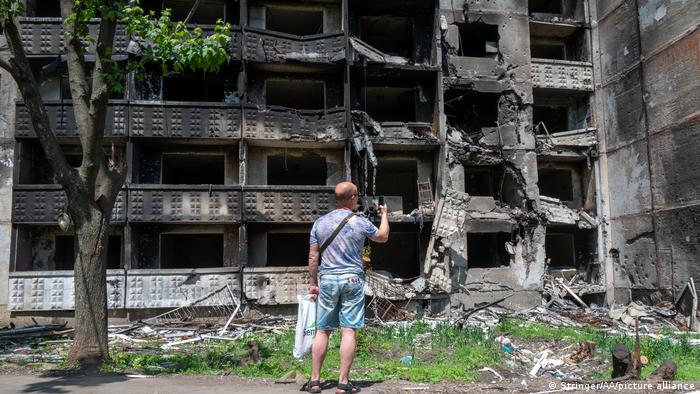17/06/2022 Ucraina (Україна), Oblast’ di Charkiv (Харківська область), Charkiv (Харків)
“If you ever come across anything suspicious like this item, please do not pick it up, contact your local law enforcement agency for assistance”
First there was a flash of light, and then a lot of smoke: In an interview with human rights organization Amnesty International, Ivan Litvynyenko recalls in detail the day that changed his life. Together with his wife Oksana and their four-year-old daughter, he was at a playground in the Ukrainian city of Kharkiv when the area was suddenly shelled. “There was smoke everywhere, and I couldn’t see anything. When the smoke cleared, I saw people lying on the ground. My wife Oksana was on the ground,” Ivan said, according to the report released Monday. Oksana, who is 41 years old, was seriously injured that day, presumably by exploding cluster munitions used by Russian troops. Researchers from Amnesty International later secured corresponding metal fragments as evidence. These were similar to fragments that had penetrated Oksana’s back, chest and abdomen. It is unclear whether she will ever recover from her injuries, if she will ever walk again or even speak. Kharkiv, home to 1.5 million inhabitants, has been under bombardment since the beginning of Russia’s war against Ukraine. According to Amnesty International, the city’s shelling by Russian forces has included the use of 9N210/9N235 cluster munitions, which are banned under international law and outlawed by an international convention. It’s far from being an isolated case.
What exactly are cluster munitions?
Cluster munitions are dropped as bombs from airplanes or fired as rockets from howitzers, artillery guns and rocket launchers. They contain hundreds of smaller bomblets that then fall indiscriminately over wide areas — ranging in size from that of a few soccer fields to several hectares of land. Not only do cluster bombs kill soldiers, they also kill civilians, including many children. Such munitions have been in use since World War Two and were used extensively in the Vietnam War, for example. During that conflict, the US dropped some 260 million mini bombs on neighboring Laos, making it the country with the world’s highest level of cluster munition contamination. According to Handicap International, a France-based charity organization, only about 40% of the smaller bomblets contained in a cluster bomb detonate upon impact. That means undetonated bomblets can still pose a deadly threat decades after they are deployed. The munitions remain ready to explode and can maim or kill a person at any time. They work in a similarly disastrous way to landmines, sometimes rendering affected areas uninhabitable. Some areas of Laos, for example, remain completely contaminated decades after the war. Civilian populations are especially affected by the use of cluster munitions. For example, Handicap International’s 2021 Cluster Munition Monitor report says that during the reporting period [the year 2020], all victims were civilians, and 44% of those injured and killed were children. The report says cluster munitions were used in Syria, but more widely still in the Nagorno-Karabakh conflict between Armenia and Azerbaijan, where at least 107 people were killed by them. The report adds that a further 242 people were injured, though the number of unreported cases is probably much higher.
Who outlaws cluster munitions and who doesn’t?
Due to their insidious and deadly impact, cluster munitions have been largely banned since 2008 by the so-called Oslo Convention. The accord is considered a milestone in the fight against mini bombs and an international ban on them came into force in 2010. The countries that have signed on have committed themselves to neither producing, stockpiling nor using the weapons. To date, 110 countries have joined the Convention on Cluster Munitions, and a further 13 nations have signed but not ratified the Convention — so they are not yet obliged to implement it. However, the world’s largest countries — including Russia, the US, China, India and Pakistan — have not signed up to the convention. In particular, Asia, the Middle East, North Africa and eastern Europe have low percentages of members. Despite the Convention’s adoption, the proportion of cluster munitions victims has increased significantly, especially in recent years, due to escalated use of the bombs but also better documentation thereof. In 2020, for instance, half of all cluster munitions casualties were recorded in Syria — where they have been used since 2012 — both from direct attacks and through previously unexploded residual bomblets.
Who produces cluster munitions?
According to the Cluster Munitions Monitor 2021, 16 countries are believed to be currently producing cluster munitions or have reserved the right to do so in the future. These include Brazil, China, Egypt, Greece, India, Iran, Israel, North Korea, Pakistan, Poland, Romania, Russia, Singapore, South Korea, Turkey and the United States. China and Russia are also believed to be actively working on developing new types of cluster munitions, says Handicap International. In response to a March 2021 query submitted to Germany’s parliament, the Bundestag found that the research and production company Bazalt was the only manufacturer of cluster munitions in the Russian Federation. Bazalt is part of Techmash, which belongs to the state-owned arms company, Rostec. A subsequent Bundestag report noted that Techmash CEO Alexander Kotschkin, speaking in May 2020, had publicly declared that his company would begin serial delivery of its latest cluster munitions to the Russian Armed Forces in 2022.
Небрежное обращение с оружием и взрывными устройствами, которые находятся в незаконном обороте, продолжает ежедневно уносить жизни наших граждан», – тогда написал в Facebook замглавы Национальной полиции Украины Вячеслав Аброськин
Dear editors, Biography of a bomb is aimed at highlighting the danger caused by unexploded bombs. Moreover, the most important aspect is that we work completely non profit, raising awerness about this topic is what drives us. We apologize if we make use of pictures in yours articles, but we need them to put a context in how findings are done. We will (and we always do) cite source and author of the picture. We thank you for your comprehension





